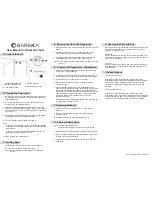
4.
Putting the cabinet into service
Installation
•
Place the cabinet on a firm surface and ensure that it is level.
•
The cabinet cannot tip over and fall due to its heavy weight.
•
Place the cabinet where the door can open 180°.
•
Ensure that the cabinet is in a well-ventilated room. Depending on its duration, a fire may
produce poisonous gasses.
Switching on the cabinet
•
On the outside of the cabinet is an electricity cable approx. 1.5 metres long that is fitted with a
three-pole CEE-form 230V 16A plug as standard. Push the plug directly into a compatible wall
socket. Do not use an extension cable.
•
Ensure that the cabinet cable is connected to an exclusive circuit in accordance with NEN
regulations.
•
Make sure that the fuse switch in the cabinet is up (position 1). The fuse switch is inside the
cabinet on the outside of the lowest technical compartment.
•
Ensure that the maximum power of the cabinet (3600W) is never exceeded.
•
Ensure that the maximum load-bearing capacity of the shelves of approx. 60 kg is never
exceeded.
•
Always keep the cabinet door closed so that any fire is limited to inside the cabinet.
•
Never impede the smoke duct and the ventilation grill by placing anything on top of the
cabinet.
Opening and closing the cabinet door
Opening the cabinet door
•
Turn the handle to the open position.
•
Open the door as far as possible without forcing until it stays open.
Closing the cabinet door
•
Turn the handle to the closed position.
•
If the door remains open, an alarm will sound after two minutes to indicate that the door must
be closed.
•
Closing the door is entirely mechanical and requires very little force from the locking
mechanism. There is therefore very little risk involved and there is little danger of injury.



















